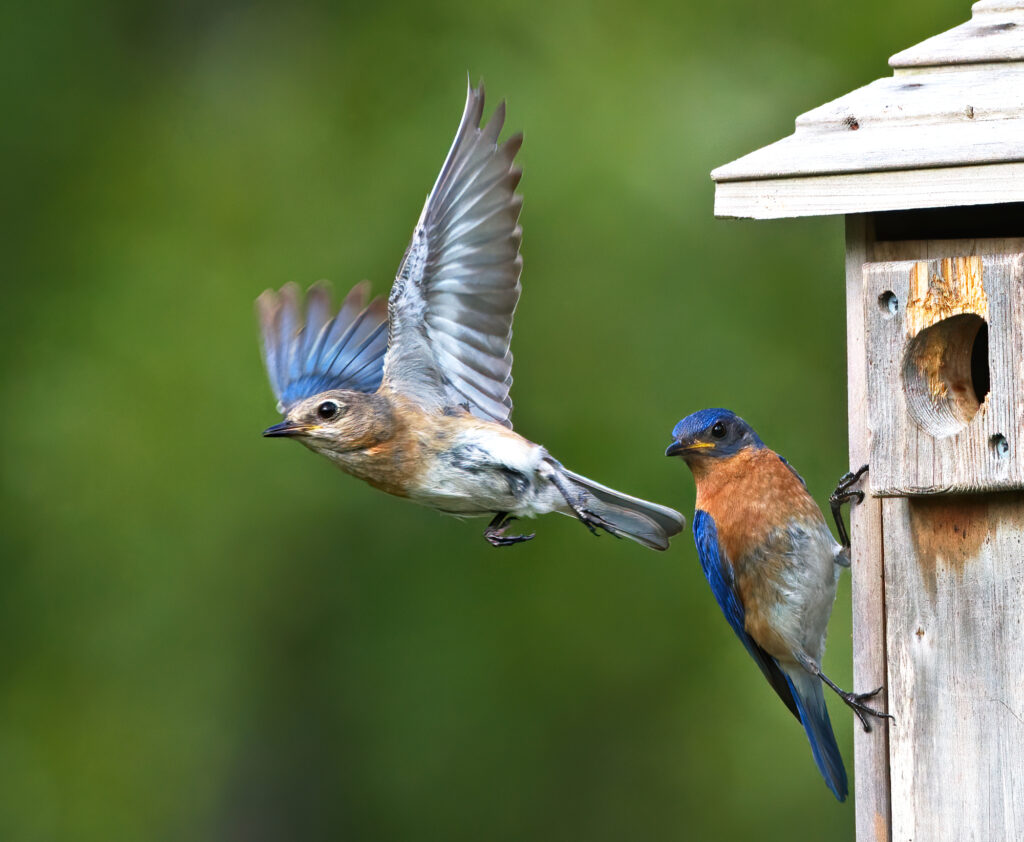According to the official records of the Maryland Ornithological Society, there are 455 registered species of birds that are found in the State, including the District of Columbia.
If you want to know more about the birds in Maryland, you’ve come to the right place!
In today’s article, we’ll showcase some of the most stunning birds that any bird watcher should look out for in the Old Line State, arranged according to their color to help you pick your favorite ones.
So without further ado, let’s dive in and check some of these birds out!
Red Birds in Maryland
House Finch

- Scientific Name: Haemorhous mexicanus
- Length: 4.9 to 6.1 in
- Weight: 0.6 to 0.9 oz
- Wingspan: 8.1 to 10.5 in
Additional Information:
The house finch isn’t only one of the most common bird species in the state, but it’s also one of the most beautiful. The male bird is easily characterized by its unique rosy red plumage that covers its face and breast.
You’ll notice that the house finch’s colors vary greatly from one bird to the other, and can have a yellowish or orange tinge.
This is because it’s directly correlated to their diet. However, females are a bit less colorful, as their plumage is mostly gray and brown.
Northern Cardinal

- Scientific Name: Cardinalis cardinalis
- Length: 8.3 to 9.1 in
- Weight: 1.5 to 1.7 oz
- Wingspan: 8.9 to 12.2 in
Additional Information:
The Northern Cardinals are among the most iconic and pretty common birds in the state. They’re easily recognizable thanks to their unmistakable crimson red body as well as the red crown over their head and the black face mask that extends to their throats.
Females of this bird species have a light yellowish-tan color but maintain the characteristic crown. These birds feed on seeds in bird feeders, and males have unique loud calls.
Keep in mind that these birds are fairly territorial to the point that males may fight their reflections on smooth surfaces!
Red-Bellied Woodpecker
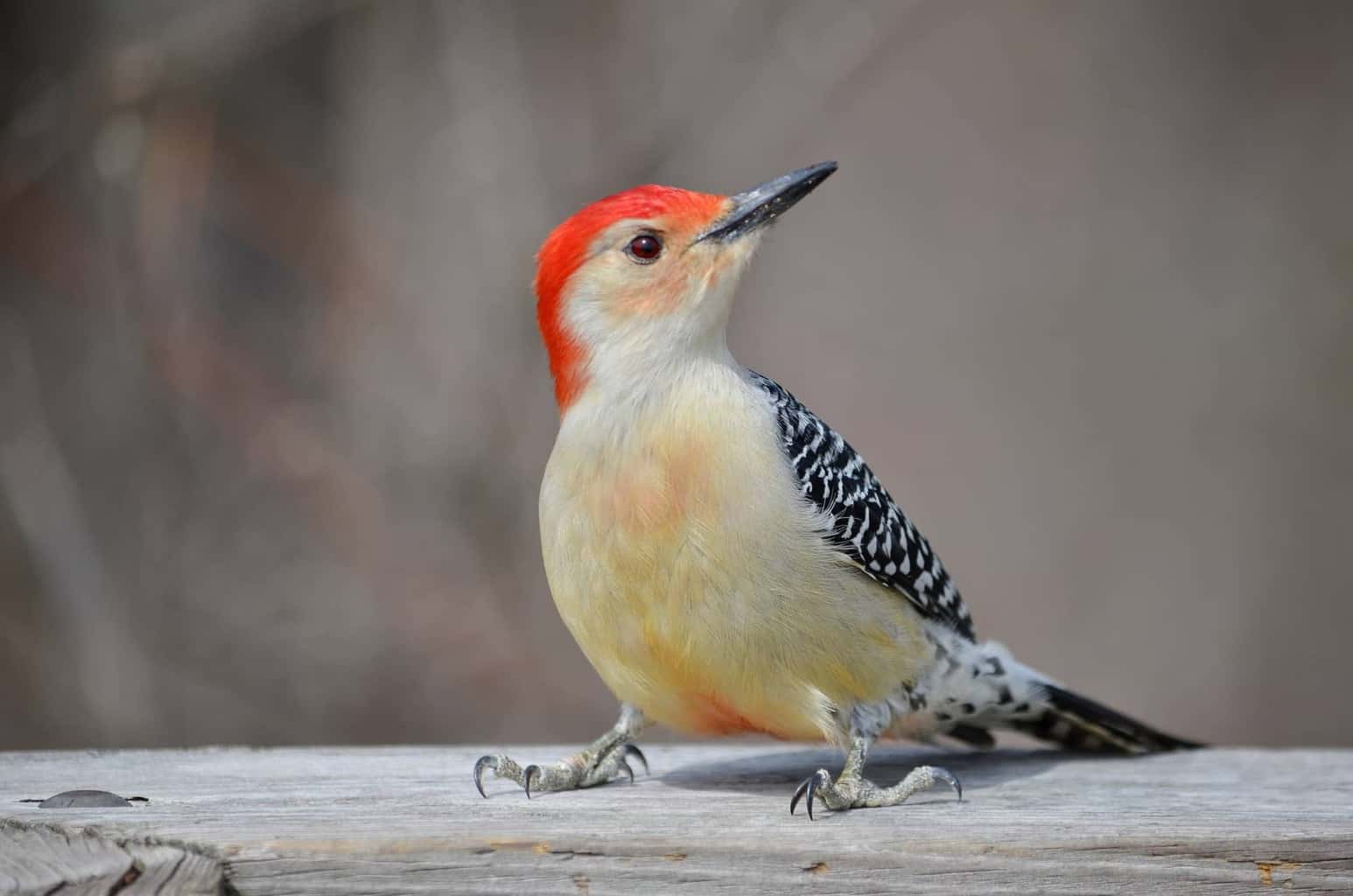
- Scientific Name: Melanerpes carolinus
- Length: 9.2 to 10.3 in
- Weight: 2.2 to 3.2 oz
- Wingspan: 15.7 to 17.8 in
Additional Information:
There are plenty of woodpecker species all over Maryland. However, the Red-bellied Woodpecker is one of the most characterized ones because they’re well adjusted to urban life and you can easily spot them hanging around your backyard.
The birds have a very characteristic batch of brilliant red on the back of the head in addition to a characteristic reddish tint on the bottom of their bellies.
Besides backyards, you can also find them foraging for insects in forests or catching small fish around ponds.
Red-Winged Blackbird
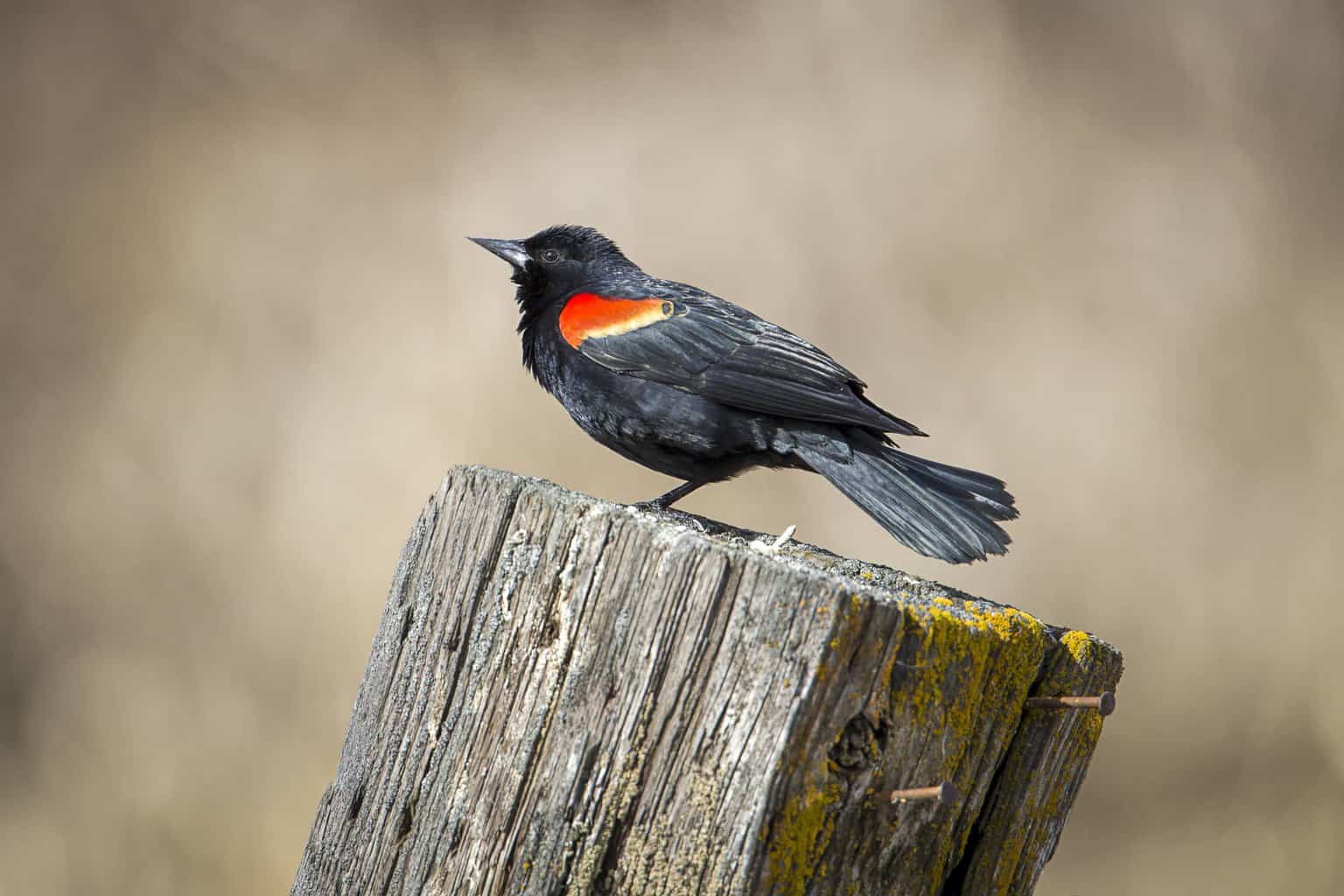
- Scientific name: Agelaius phoeniceus
- Length: 6.7 to 9.1 in
- Weight: 1.1 to 2.7 oz
- Wingspan: 12.2 to 15.8 in
Additional Information:
Blackbirds belong to the family of thrushes. The common blackbird is known for its characteristic all-black shiny plumage. However, the male of the Red-winged Blackbird has a unique red and yellow batch that covers both of their shoulders.
Females, however, don’t share this characteristic feature, since they have mostly dark brown plumage with white streaking that covers their bellies and wings.
Surprisingly enough, the Red-winged Blackbird is one of the most common species of thrushes and blackbirds in the state of Maryland, and they typically hang around various bodies of water, such as marshes, rivers, lakes, etc.
Pileated Woodpecker

- Scientific Name: Dryocopus pileatus
- Length: 16 to 19 In
- Weight: 8.8 to 14.1 oz
- Wingspan: 26 to 30 In
Additional Information:
In addition to the Red-bellied Woodpecker, the Pileated Woodpecker is also fairly common in the state of Maryland.
They have a characteristic red cap at the top of their head that makes them easily recognizable. The Pileated Woodpecker always digs rectangular or square holes in nearby trees searching for insects, and they’re the main inspiration behind Woody Woodpecker.
In addition to insects, the Pileated Woodpecker would also enjoy a meal of nuts and fruits. However, ants usually make up more than half of what they eat every day.
Red-Tailed Hawk
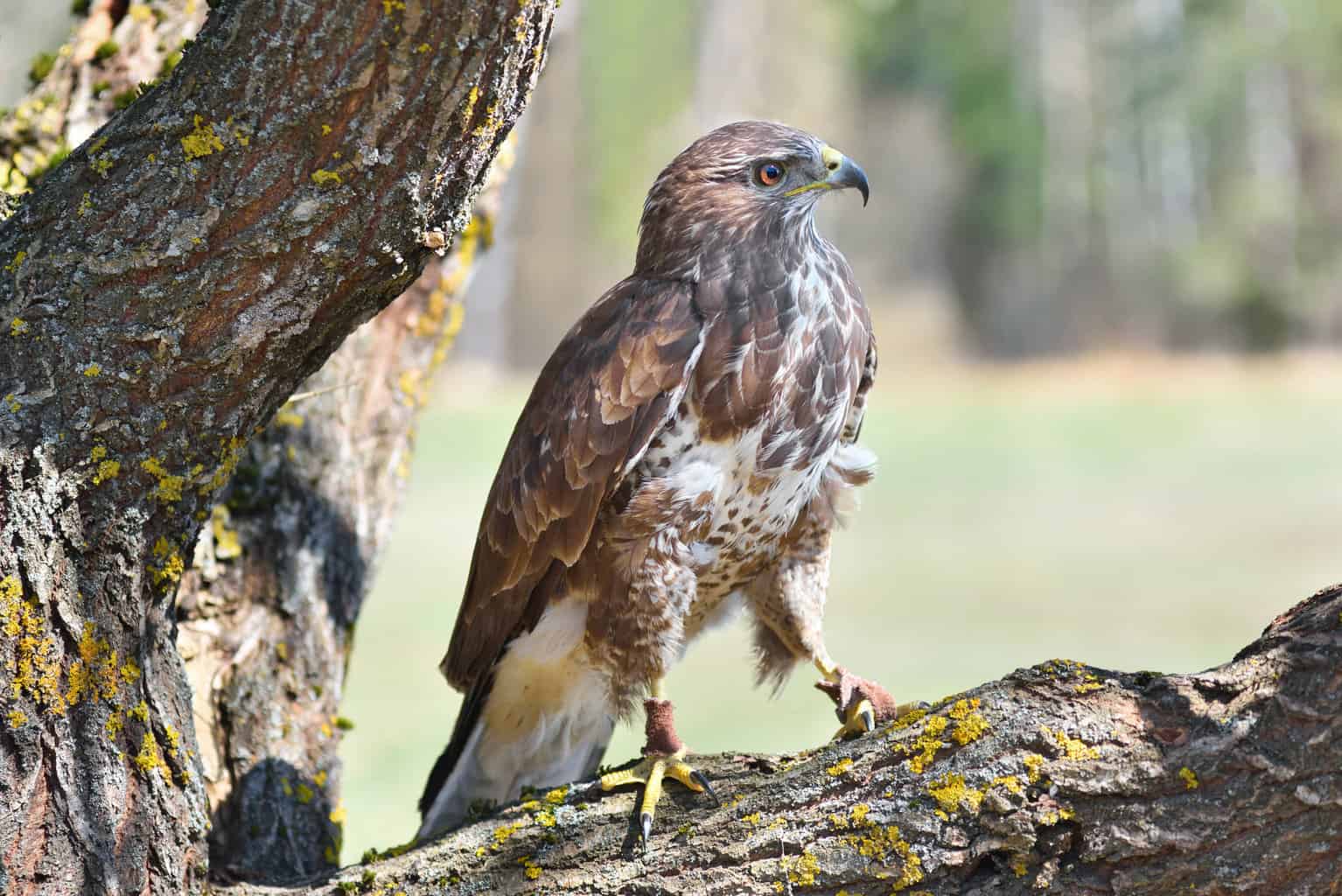
- Scientific Name: Buteo jamaicensis
- Length: 17.7 to 22.1 in
- Weight: 24.3 to 45.9 oz
- Wingspan: 44.9 to 52.4 in
Additional Information:
The Red-tailed Hawk is one of the largest raptors that you may find in Maryland. You can typically spot them soaring high in the sky, perching on posts and high telephone cables, or hovering over the countryside area.
The bird has a striking and intimidating look with characteristic long and red plumage at its tail, which is one of the easiest ways to identify them.
The Red-tailed Hawk also has reddish-brown plumage but you shouldn’t rely on them to identify the bird because they exist in other shades of white, brown, and black too.
They feed on a variety of small mammals and reptiles, such as snakes, mice, squirrels, and frogs, so they’re typically found around the wooded areas where their prey forage.
Blue Birds in Maryland
Eastern Bluebird
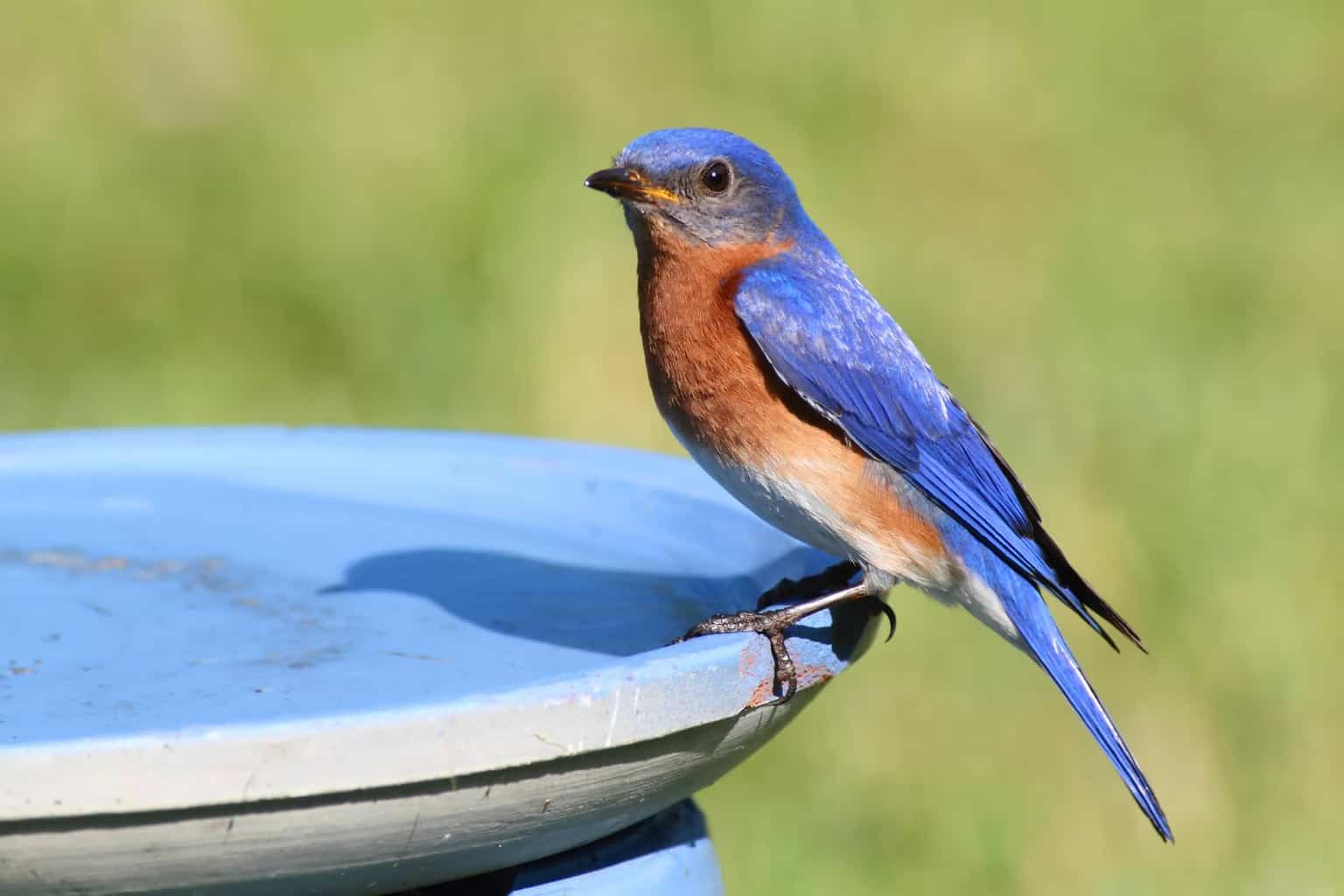
- Scientific Name: Sialia sialis
- Length: 6.3 to 8.3 in
- Weight: 0.9 to 1.2 oz
- Wingspan: 9.8 to 12.6 in
Additional Information:
The Eastern Bluebird is one of the most common blue-colored birds in Maryland. They have a vibrant blue color that covers all of their heads, backs, and wings. The rest of their body is either brownish, bronze, or white.
These birds like to perch on fence posts and telephone wires. You can see them flying above open fields in the countryside looking for mealworms, their favorite food. However, they can also eat small spiders, lizards, and tree frogs.
Blue Jay

- Scientific Name: Cyanocitta cristata
- Length: 8.6 to 11.8 in
- Weight: 2.5 to 3.5 oz
- Wingspan: 13.3 to 16.9 in
Additional Information:
The Blue Jay is one of the most beautiful blue-colored birds that you can find out there. They have a unique feather structure that reflects the blue color from white light, giving them the iconic color despite not having any blue pigments in them.
The birds exist in Maryland all year round and you can easily tell that they’re nearby due to their noisy “chattering” nature towards each other.
They enjoy a variety of foods, including mixed seeds, insects, nuts, and more!
Common Grackle
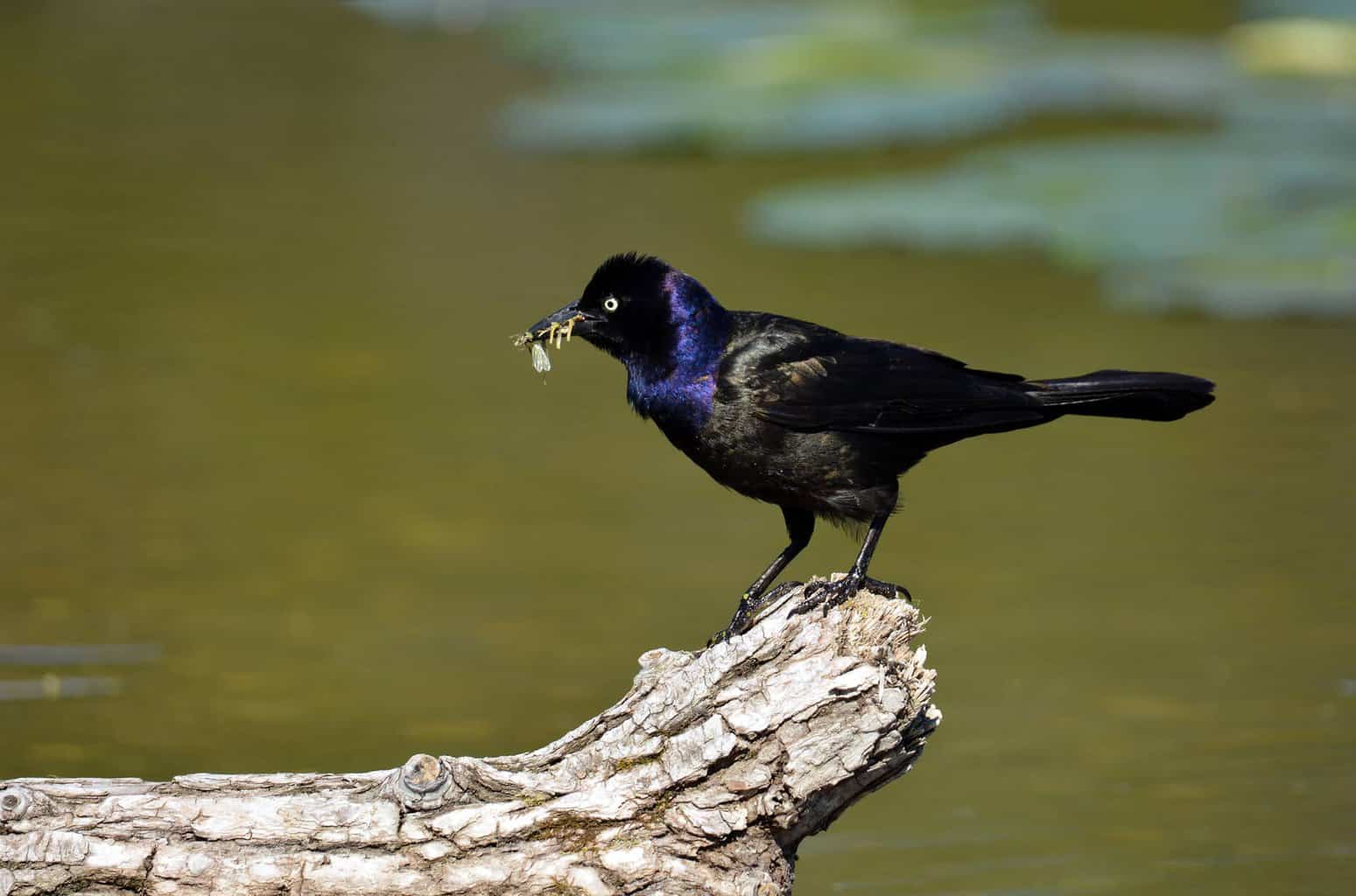
- Scientific name: Quiscalus quiscula
- Length: 11.0 to 13.4 in
- Weight: 2.6 to 5.0 oz
- Wingspan: 14.2 to 18.1 in
Additional Information:
The Common Grackle is pretty abundant in the state of Maryland and you can find them all year round. They have an especially amazing feather structure that reflects light into different colors.
The relatively slim bird is known for its purplish, blue, and brown plumage, especially the male ones.
Another way to easily identify the Common Grackles is that they like to be in large flocks and make a lot of noticeable noise when they’re conversing with each other!
Great Blue Heron
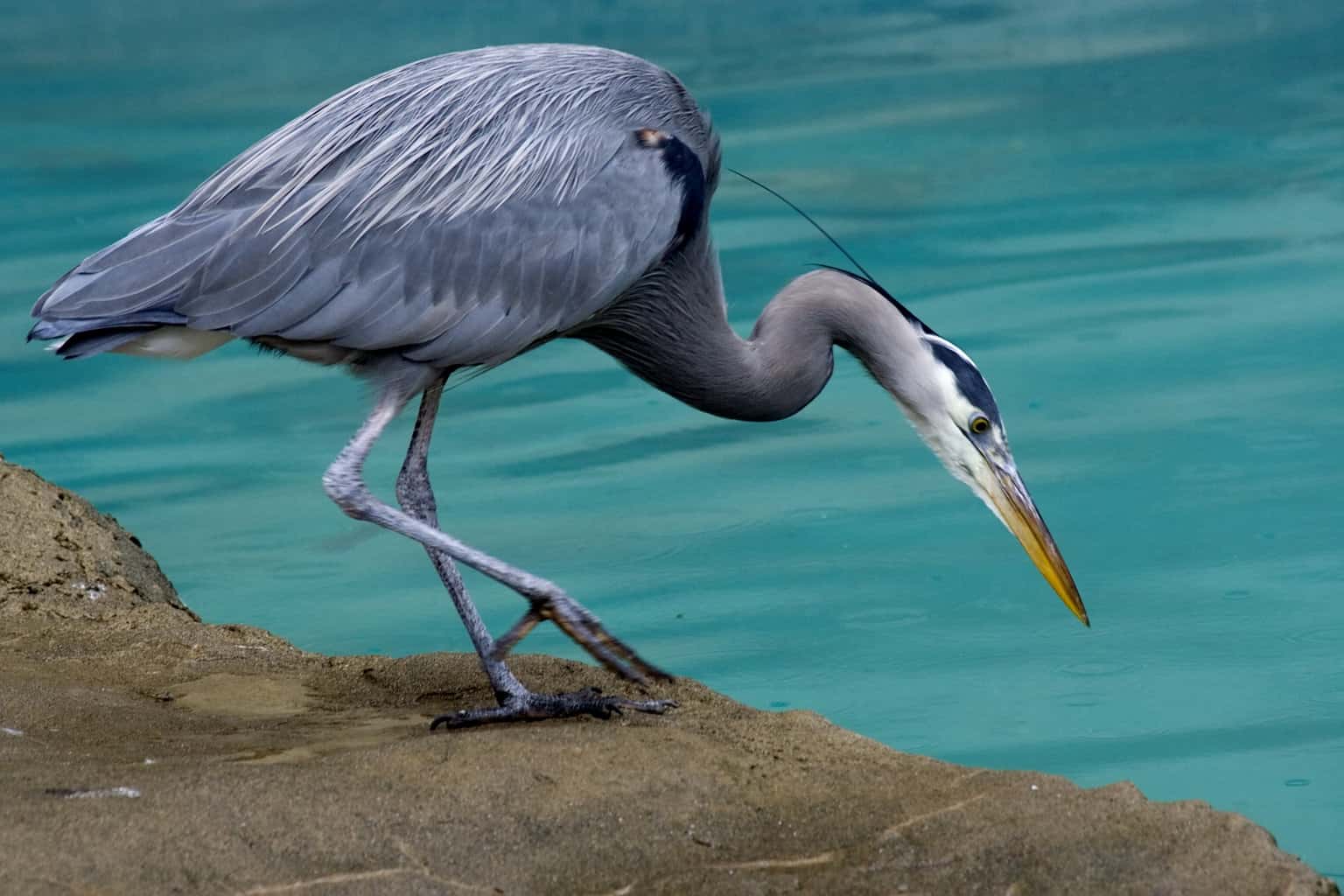
- Scientific Name: Ardea herodias
- Length: 38.2 to 53.9 in
- Weight: 74.1 to 88.2 oz
- Wingspan: 65.8 to 79.1 in
Additional Information:
The Great Blue Heron is one of the largest herons in North America, if not the largest one. The heron is also one of the most iconic birds you’ll come across in the Chesapeake country.
While in Maryland, you can easily find the Great Blue Heron just about anywhere where you can find water and plenty of fish.
In addition to fish, they also feed on a variety of insects and aquatic animals, such as small shrimps and crabs.
Green Birds in Maryland
Ruby-Throated Hummingbird
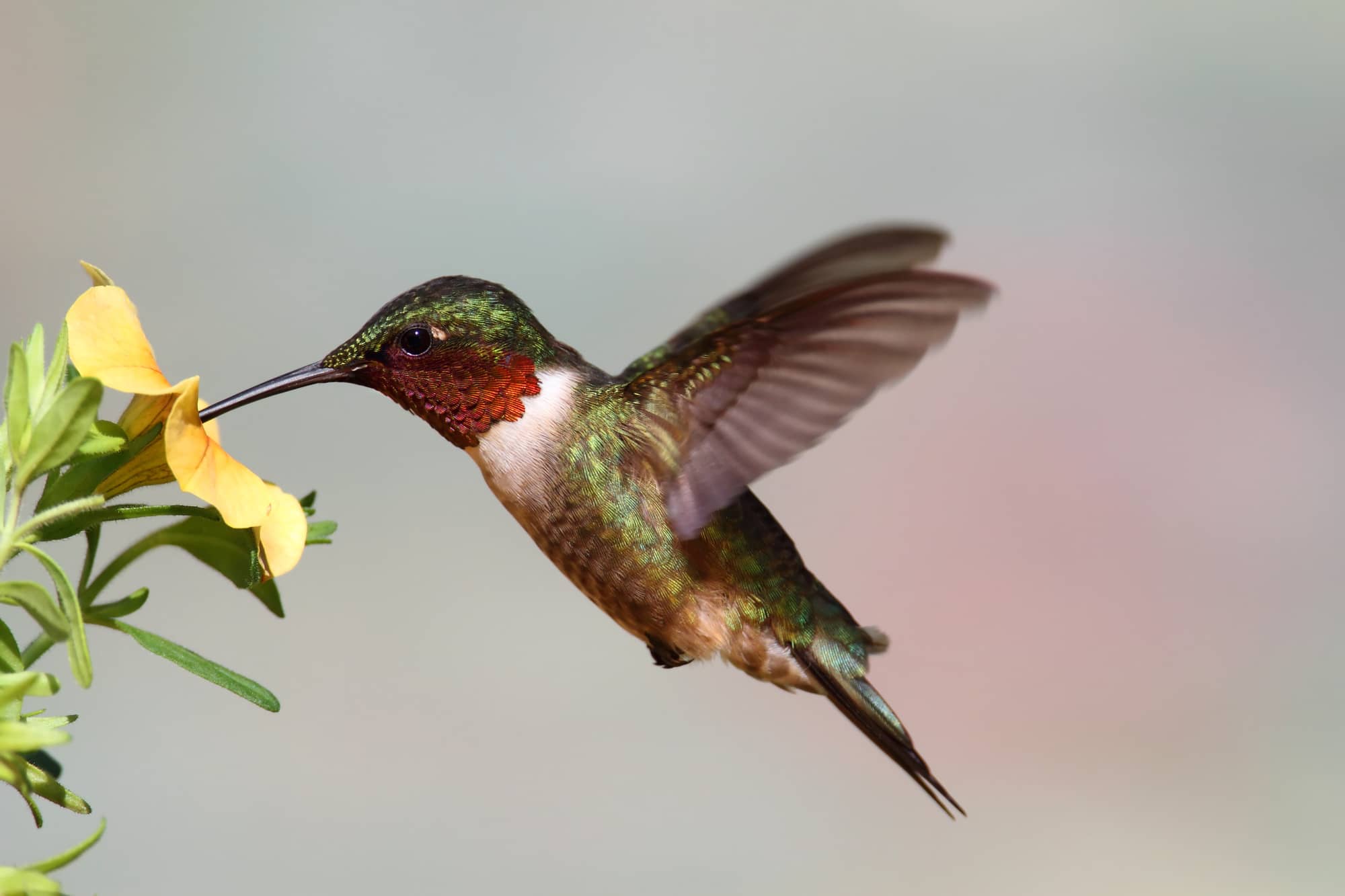
- Scientific Name: Archilochus colubris
- Length: 2.8 to 3.5 in
- Weight: 0.1 to 0.2 oz
- Wingspan: 3.1 to 4.3 in
Additional Information:
Unfortunately, the state of Maryland, as well as the Northeast, isn’t the ideal place to search for hummingbirds, as most of the state’s hummingbird collection is listed as “rare to find”.
However, the only species of hummingbird that are decently available around the state is the Ruby-throated Hummingbird. The good news is, it’s also one of the most beautiful ones!
The males of this hummingbird species have characteristic and vivid ruby-red plumage on their throats as well as black masks on their faces. The rest of their body ranges from iridescent green at the back to pale greyish green on the side.
Green Heron
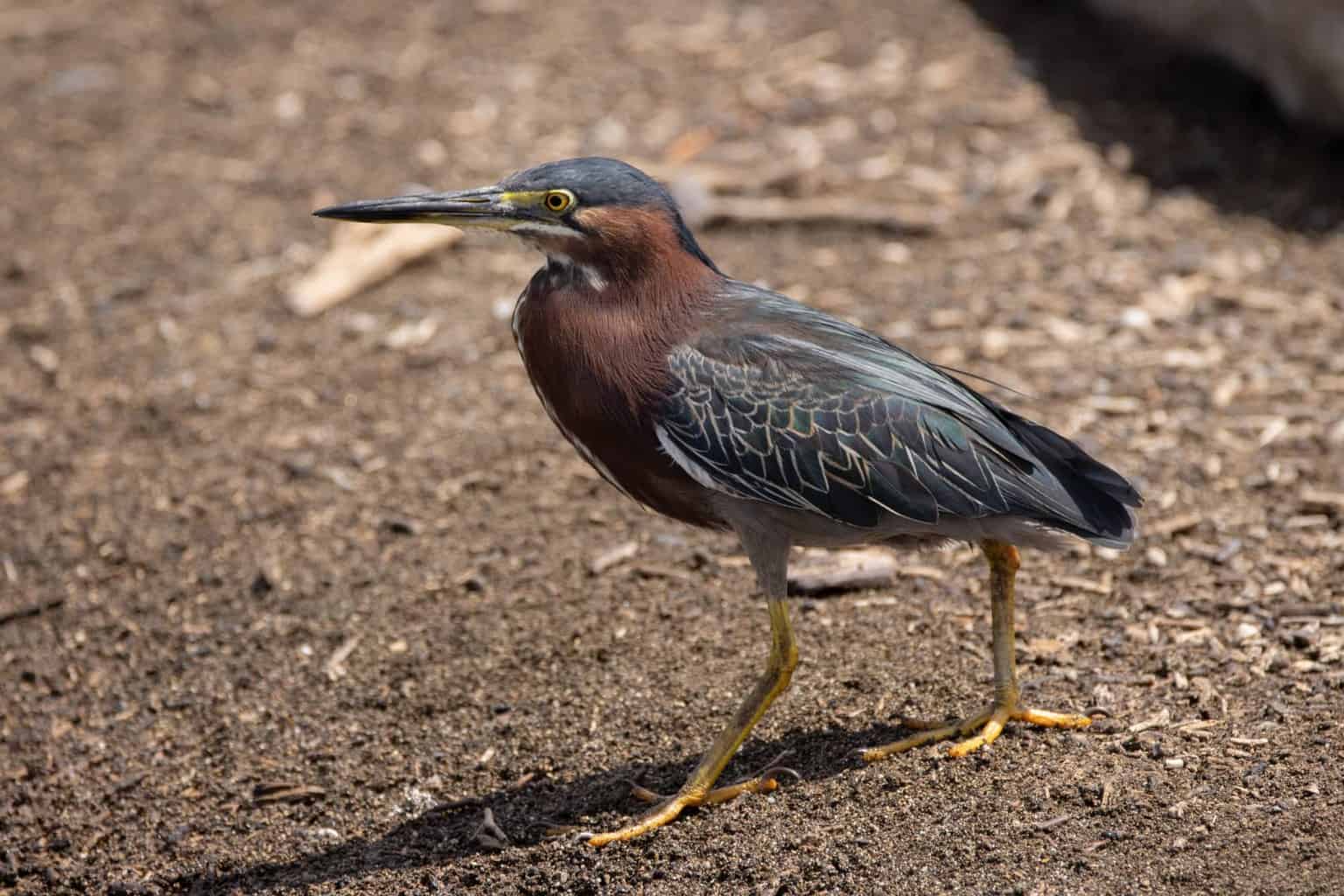
- Scientific Name: Butorides virescens
- Length: 16 to 18 in
- Weight: 8.3 to 8.7 oz
- Wingspan: 25.2 to 26.8 in
Additional Information:
The Green Heron is relatively smaller than the Great Blue Heron. Similar to the great blue one, this species had been quite common around swamps and marshes all over the state.
They have a characteristic green plumage over their heads, which is where they’ve got their name.
Unlike the Great Blue Heron, these green ones are quite rare to spot nowadays due to the destruction of their habitat.
Orange Birds in Maryland
Baltimore Oriole
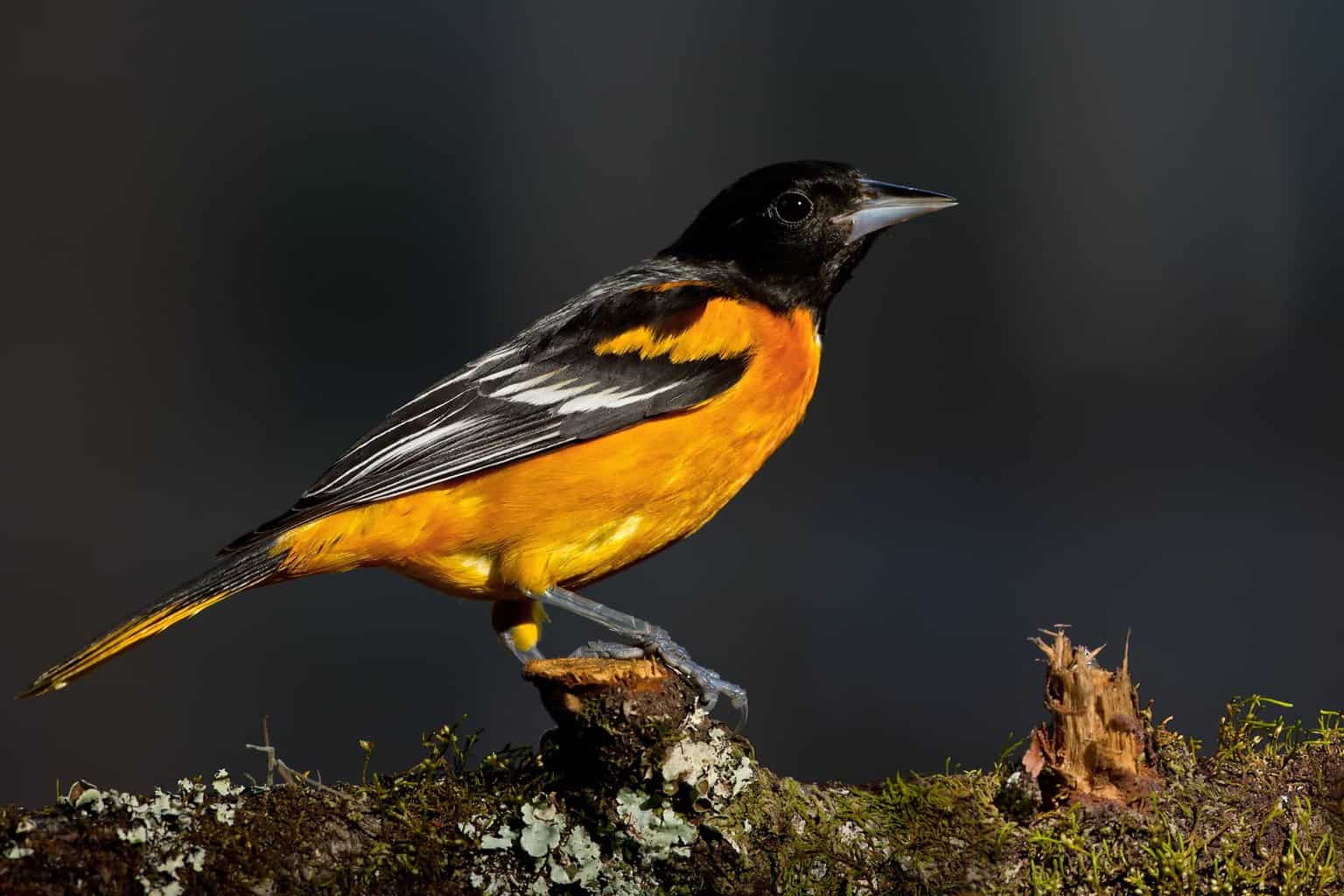
- Scientific Name: Icterus galbula
- Length: 5.8 to 7.8 in
- Weight: 2.3 to 3.5 oz
- Wingspan: 3.5 to 4.7 in
Additional Information:
Baltimore Orioles are not only quite common in Maryland, but they’re also the state birds!
However, they’re not named after the state’s capital. Instead, they’re named after the orange color of Lord Baltimore’s coat of arms.
The orange color is found in both males and females. However, the color is more vibrant and abundant in males than females, as females can sometimes show relatively pale yellow colors.
They have orange plumage around the wings, underparts, and rump. The rest of their body is covered with black feathers and white markings.
American Robin
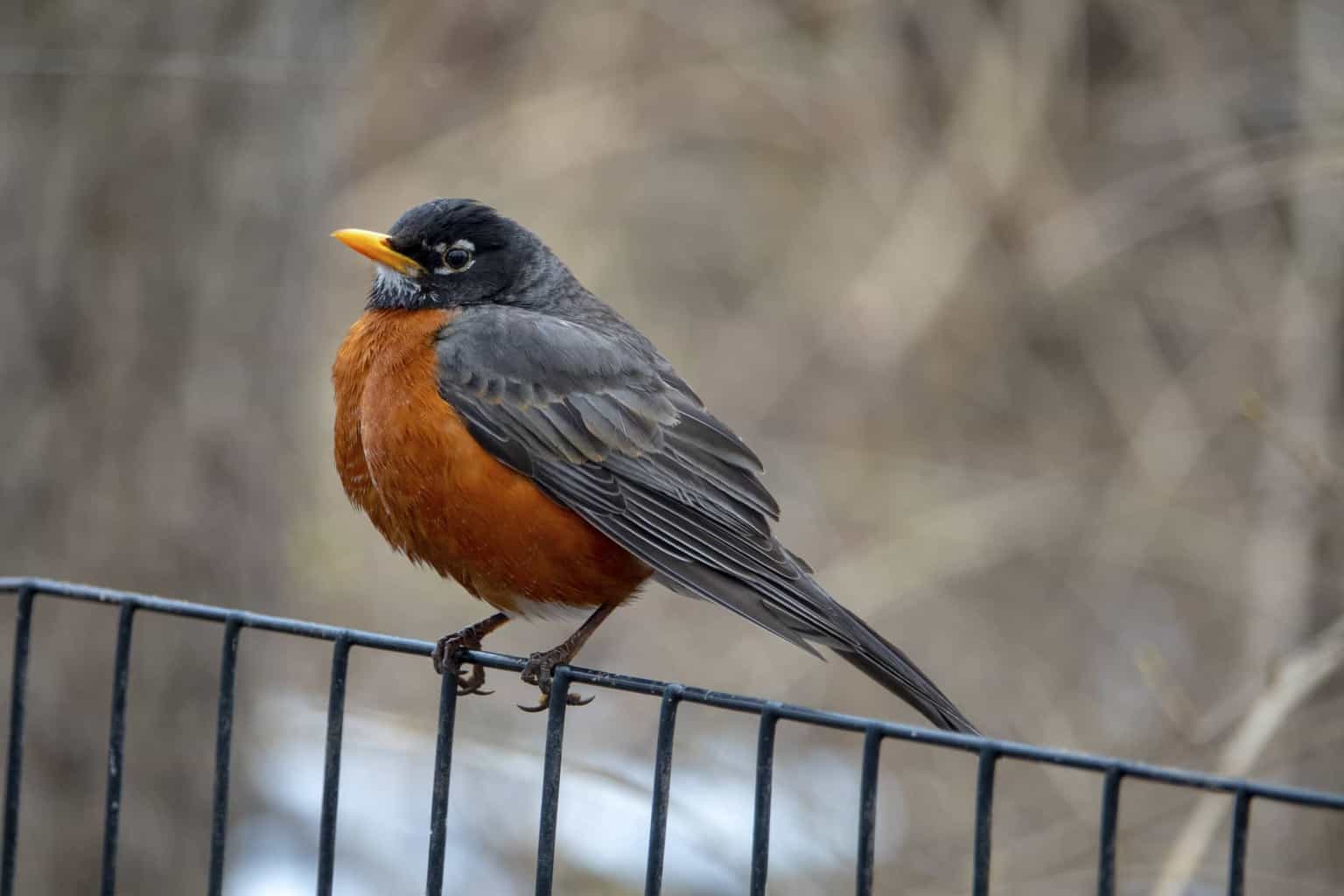
- Scientific Name: Turdus migratorius
- Length: 9.0 to 11.0 in
- Weight: 2.3 to 2.8 oz
- Wingspan: 14.7 to 16.5 in
Additional Information:
American Robins are one of the most widespread and beloved birds in the United States.
The songbird is known for its amazing reddish-orange color that covers the feathers of its breasts. The rest of the body is typically dark black.
Another extremely colorful feature of the bird is its eggs. If you approach their nests, you’ll encounter one of the most brightly colored sky-blue eggs you’ve ever seen!
The bird has a distinctive song and they like hanging around bird feeders early in the morning.
Scarlet Tanager
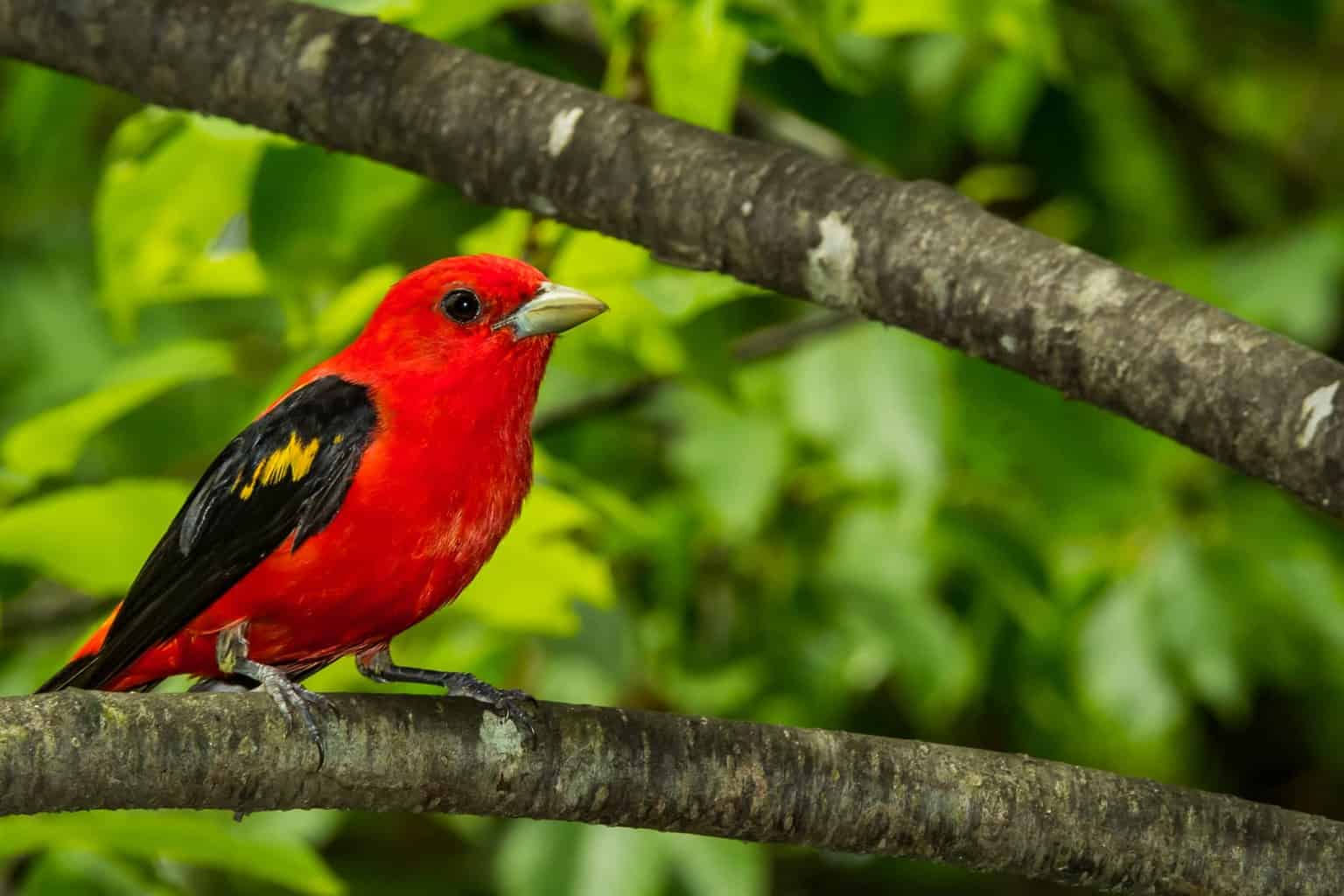
- Scientific Name: Piranga olivacea
- Length: 6.3 to 6.7 in
- Weight: 0.8 to 1.3 oz
- Wingspan: 9.8 to 11.4 in
Additional Information:
Despite the name, the Scarlet Tanager is neither scarlet red nor a tanager. Their classification has been recently changed from tanagers to cardinals.
As for the color, they have a flaming orange color that covers their entire body except for their black tails and wings. The bird is pretty common in the state and they typically feed on fruits and insects.
Yellow Birds in Maryland
American Yellow Warbler
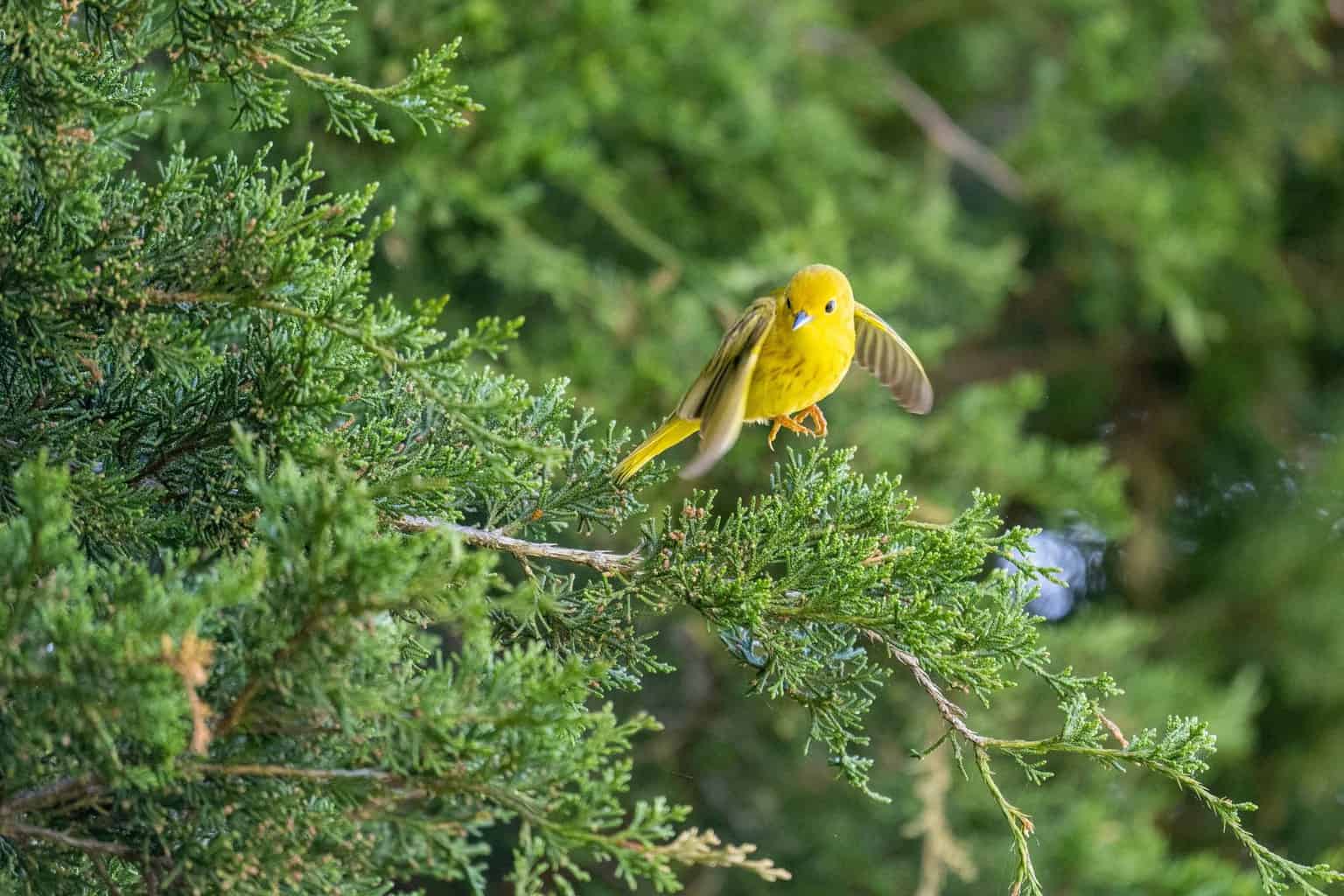
- Scientific Name: Setophaga petechia
- Length: 4.7 to 5.1 in
- Weight: 0.3 to 0.4 oz
- Wingspan: 6.3 to 7.9 in
Additional Information:
There are plenty of New World warblers all over the North East. However, the American Yellow Warbler is easily one of the most common and memorable ones.
These colorful birds live in poplar forests of the states but you can also find them foraging around lakes with nearby perching trees.
The bird has a bright yellow plumage that covers the majority of its body with some touches of olive green on its back.
American Goldfinch
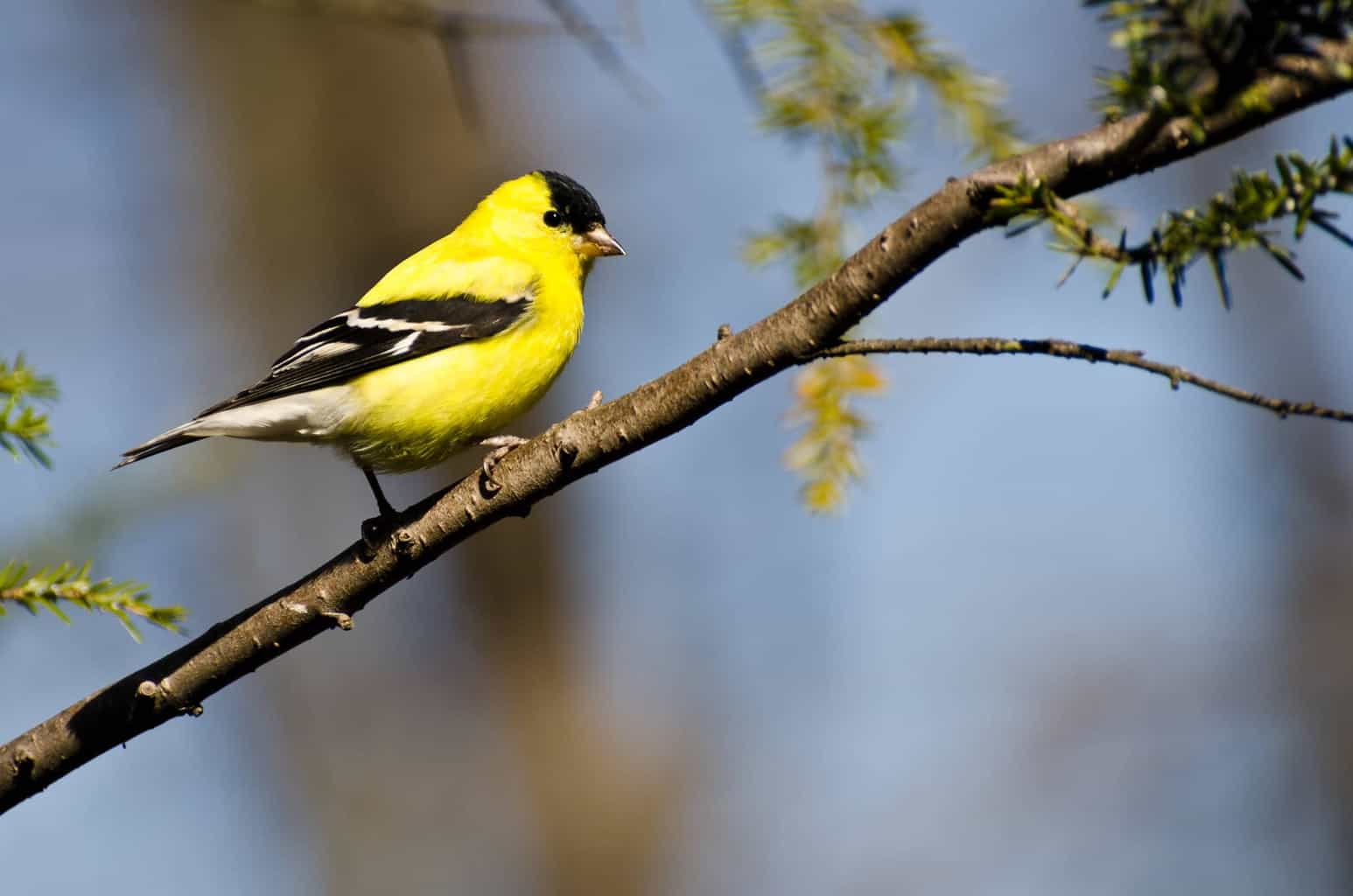
- Scientific Name: Spinus tristis
- Length: 4.3 to 5.5 in
- Weight: 0.39 to 0.71 oz
- Wingspan: 7.5 to 8.7 in
Additional Information:
The American Goldfinch is one of the easiest birds to identify, even by beginner bird watchers. For starters, they’re extremely common all over Maryland, so you won’t have a hard time spotting one of them.
Additionally, they fly in a very specific way and will often land in your backyard while foraging, whether you have a bird feeder or not!
Lastly and most importantly, these birds, especially the male, have bright golden yellow and black plumage that covers most of their body.
Other Birds to Watch in Maryland
Osprey
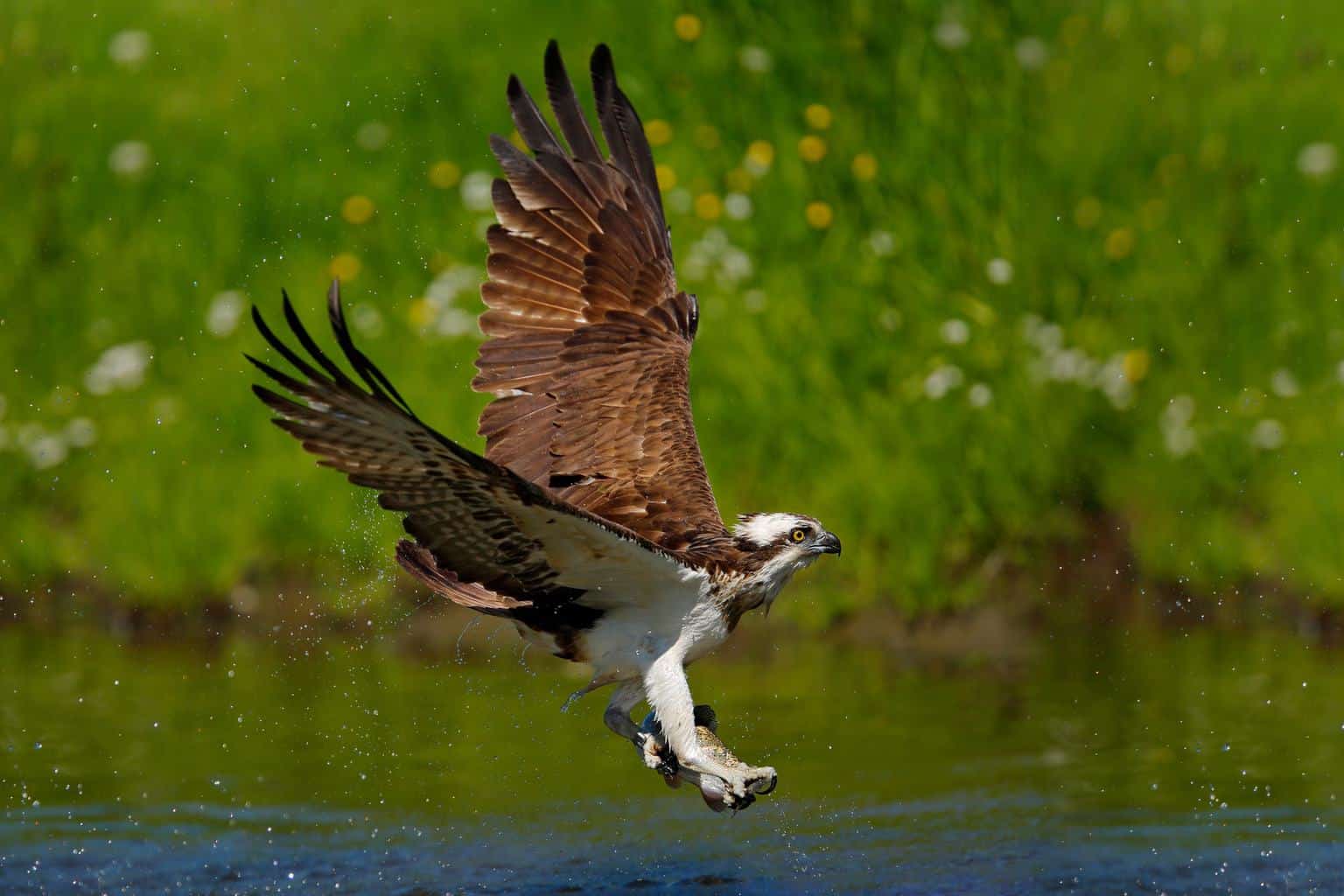
- Scientific Name: Pandion haliaetus
- Length: 21.3 to 22.8 in
- Weight: 49.4 to 70.5 oz
- Wingspan: 59.1 to 70.9 in
Additional Information:
These are large raptors that are also known as the “sea hawks”, “fish hawks”, or the “river hawks”.
Although these birds exist in various parts all over the world, Maryland takes pride in having one of the largest concentrations of breeding Ospreys all over the world.
These birds feed exclusively on fish, so they’re typically found in the marshy habitat of Blackwater National Wildlife Refuge from spring to fall.
Bald Eagle
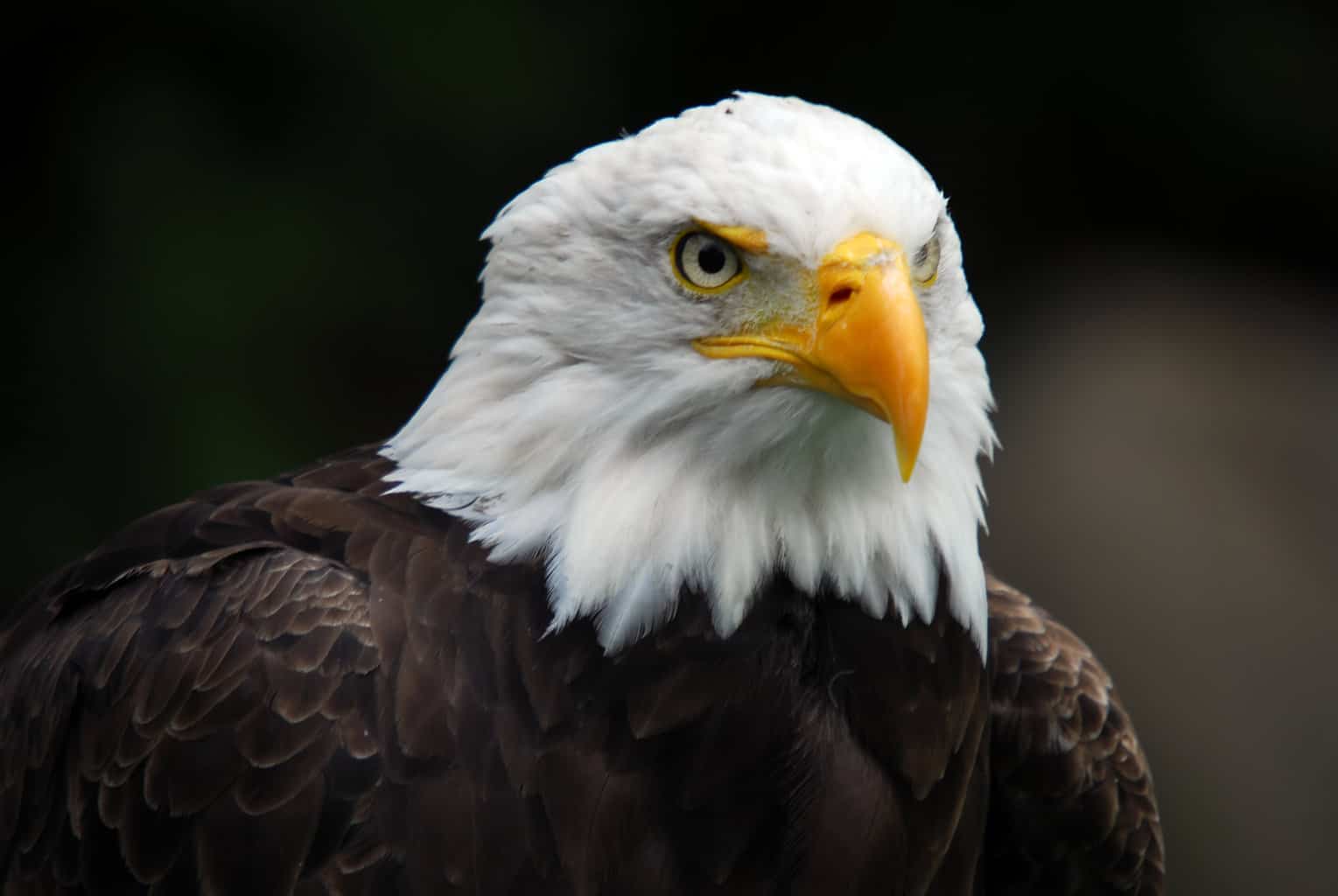
- Scientific Name: Haliaeetus leucocephalus
- Length: 27.9 to 37.8 in
- Weight: 105.8 to 222.2 oz
- Wingspan: 80.1 to 80.5 in
Additional Information:
The national bird of the United States of America is found all year round in Maryland.
The majestic bird with its characteristic white head and brown body is also a huge recovery success from an endangered species about a decade ago to a fairly common bird once again!
Similar to the Ospreys, they’re also found in the Blackwater National Wildlife Refuge. They’re incredibly large birds and built one of the biggest nests!
Bald Eagles typically feed on fish as their primary food source. However, they can also eat a wide range of smaller birds and animals, such as waterfowls, raccoons, rabbits, and squirrels
White-Breasted Nuthatch
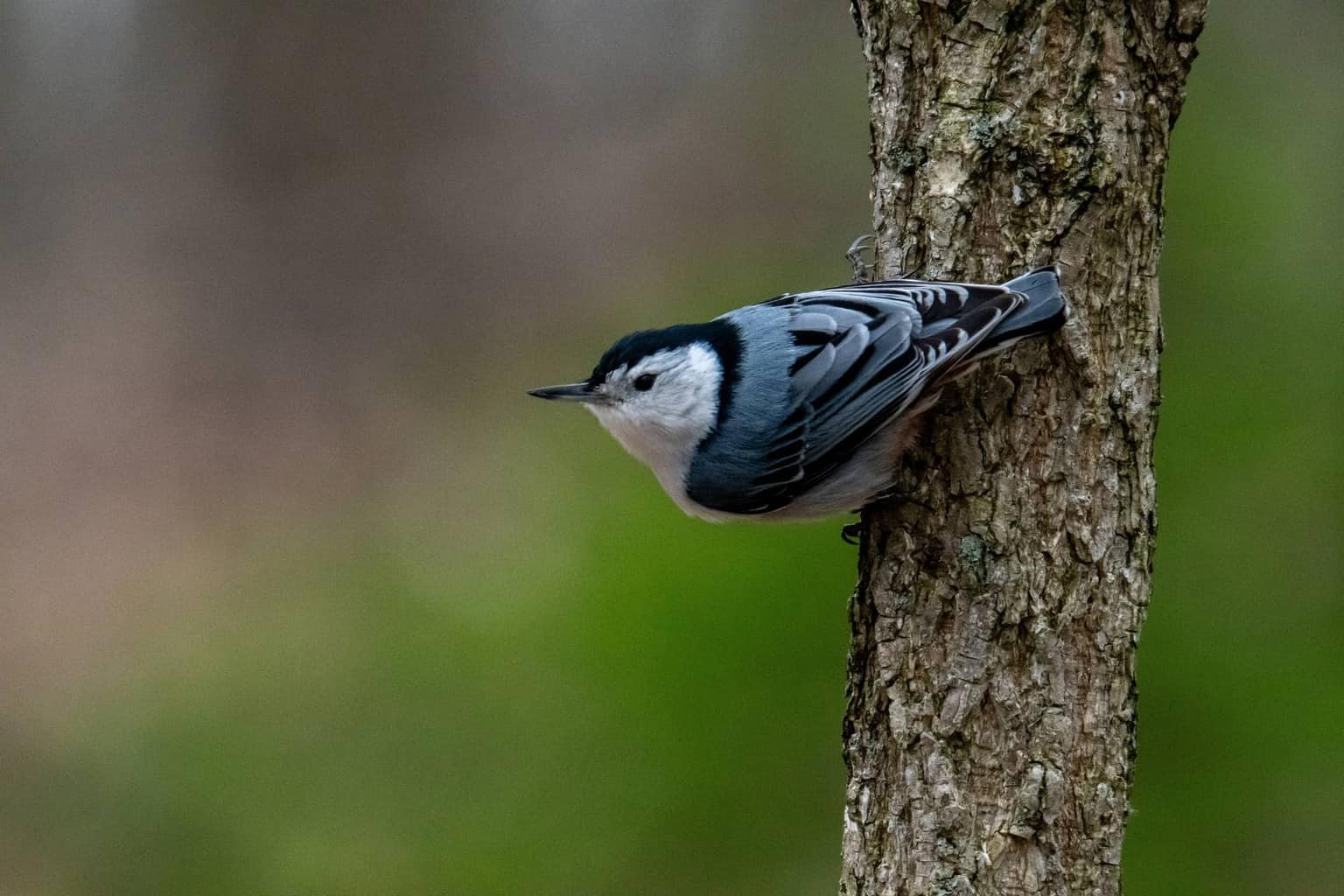
- Scientific name: Sitta carolinensis
- Length: 5.1 to 5.5 in
- Weight: 0.6 to 1.1 oz
- Wingspan: 7.9 to 10.6 in
Additional Information:
The White-breasted Nuthatch is fairly common all year round in Maryland. As the name suggests, it has a white color breast, but you can characterize it by its short tail, long pointy bills, and bluish-gray plumage on the back.
The bird is typically found in urban regions and state parks but can be also found in the deciduous forests around the state.
Purple Martin
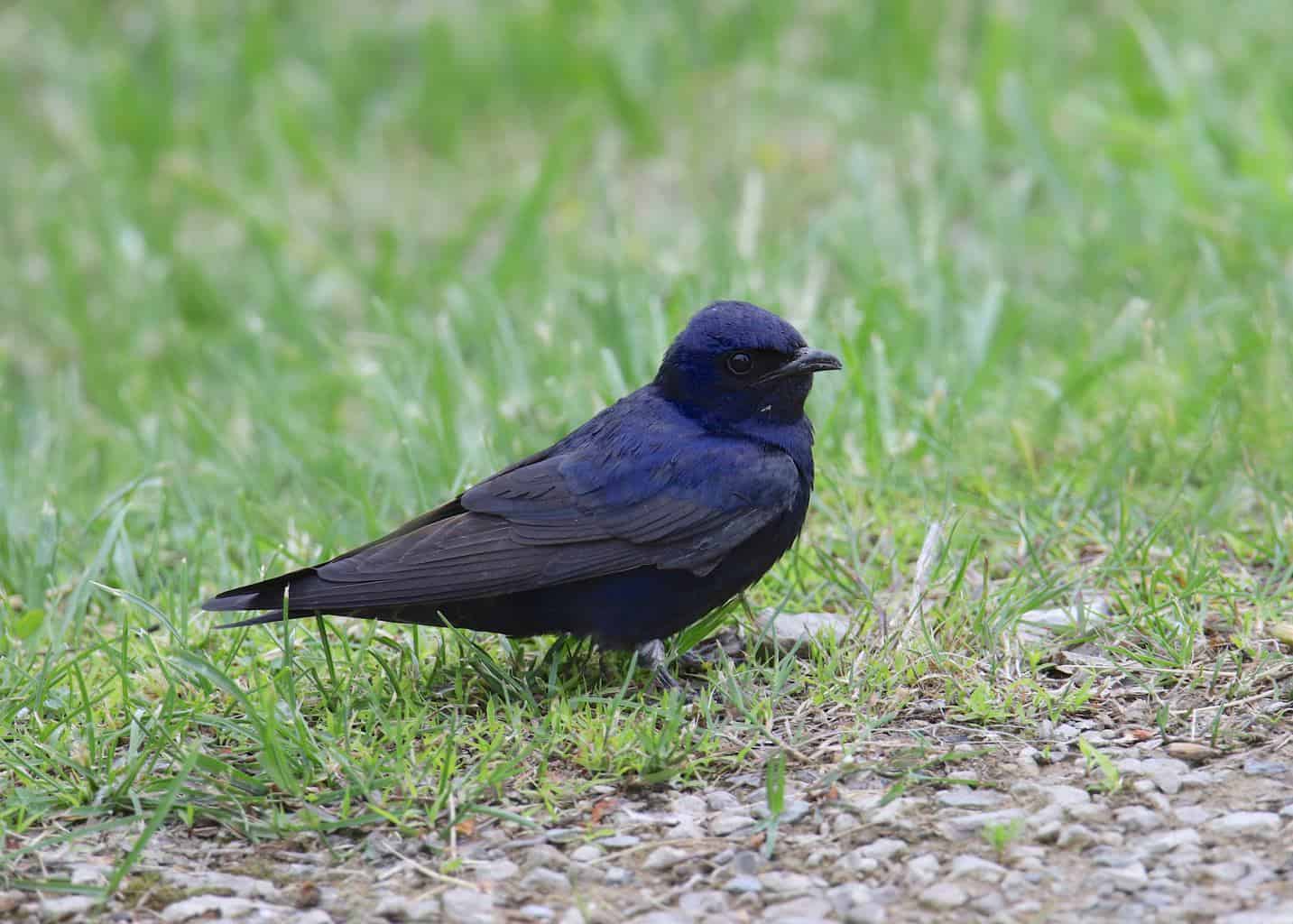
- Scientific Name: Progne subis
- Length: 7.5 to 7.9 in
- Weight: 1.6 to 2.1 oz
- Wingspan: 15.3 to 16.1 in
Additional Information:
The Purple Martin is one of the most uniquely colored birds in the state. They rock a bluish-purplish plumage that covers their heads and shoulders. The rest of their body is dark grey.
They originally liked to build their twig nest in hollowed-out trees. However, when new colonists cleared these forests for housing and agriculture, the bird species started to decline in numbers, so it may take some time before you’re able to spot one.
European Starling
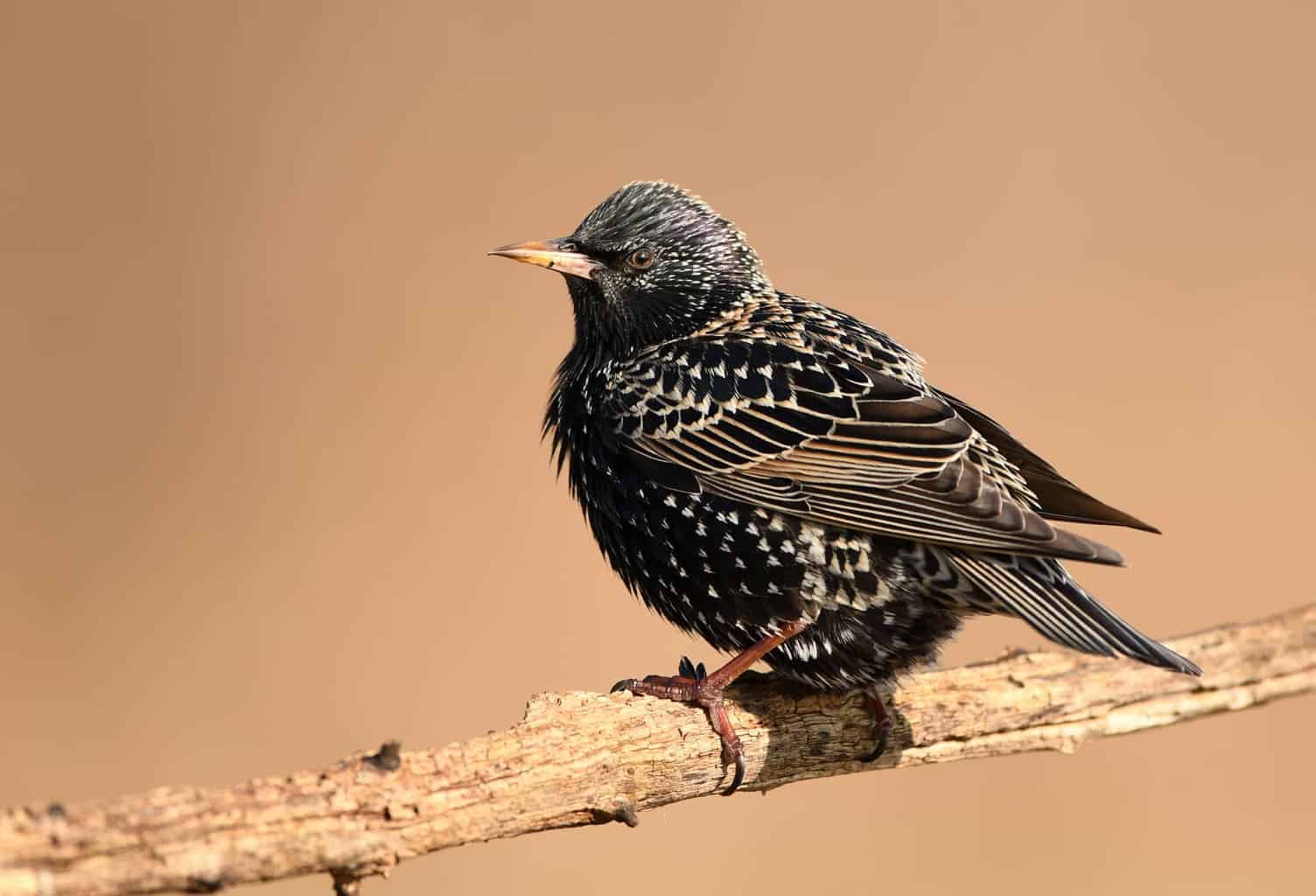
- Scientific name: Sturnus vulgaris
- Length: 7.9 to 9.1 in
- Weight: 2.1 to 3.4 oz
- Wingspan: 12.2 to 15.8 in
Additional Information:
The name of the bird is quite misleading, as these small birds are pretty common all over North America, including the state of Maryland.
These birds are well-acclimated to urban neighborhoods and visit backyards and bird feeders frequently while foraging.
They have a magnificent plumage of iridescent purple and green, so their feathers change in color as you look at them from different angles.
An important tip here is to look for them in the summer, as they change their feather coat between seasons.
Brown-Headed Cowbirds
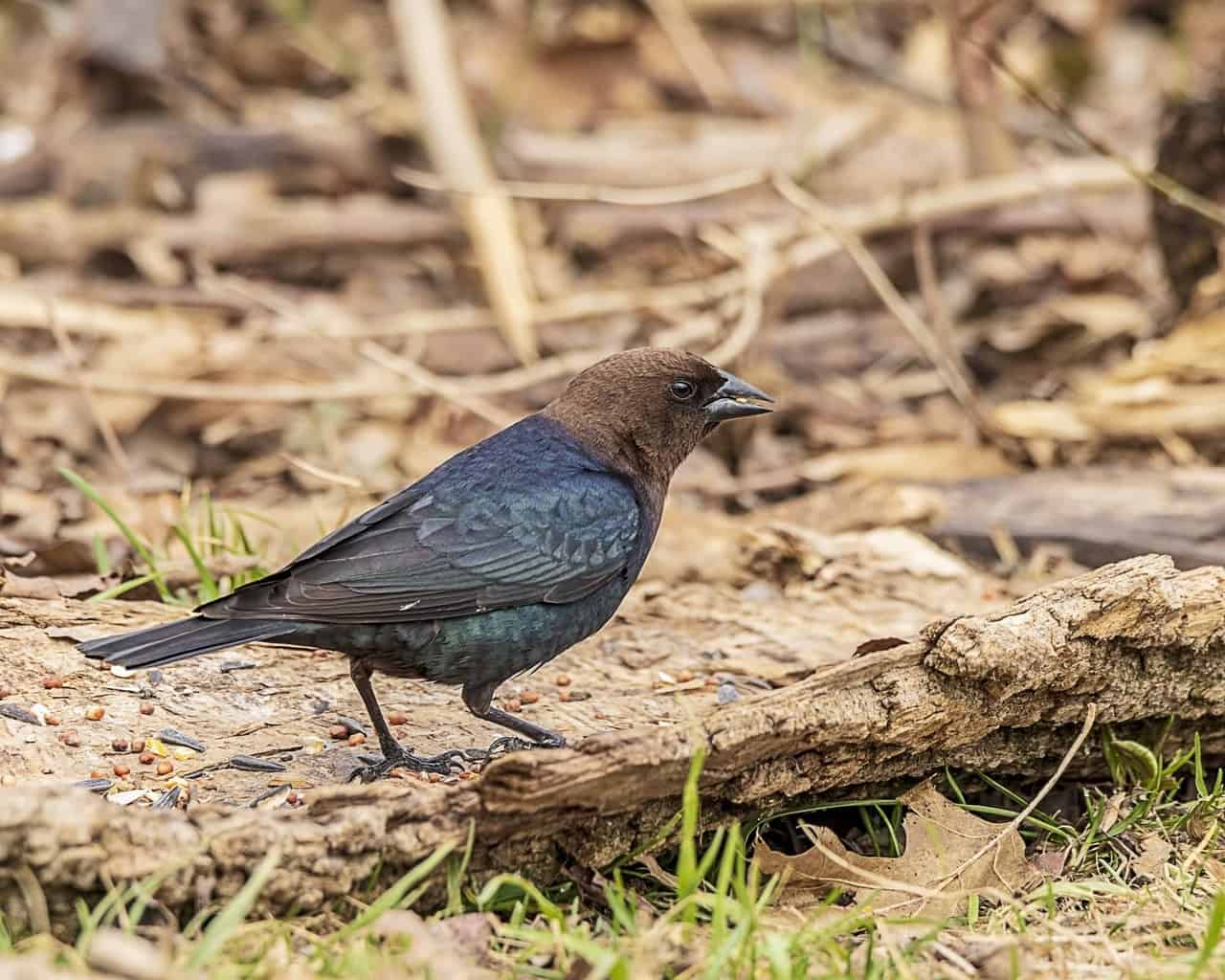
- Scientific Name: Molothrus ater
- Length: 7.5 to 8.7 in (males) – 6.3 to 7.9 in (females)
- Weight: 1.5 to 1.8 oz (males) – 1.3 to 1.6 oz (female)
- Wingspan: 14.0 to 14.4 in (males) – 15.0 to 12.6 in (females)
Additional Information:
The Brown-headed Cowbirds are brood parasitic birds, which means that they often lay their eggs in other birds’ nests so that they are raised and fed by other birds.
This behavior has caused a lot of bird species to decline in number, which is why these birds are considered a nuisance by many people.
You can identify one by its all-black body except for its brown plumage all over the head and neck.
Cooper’s Hawk
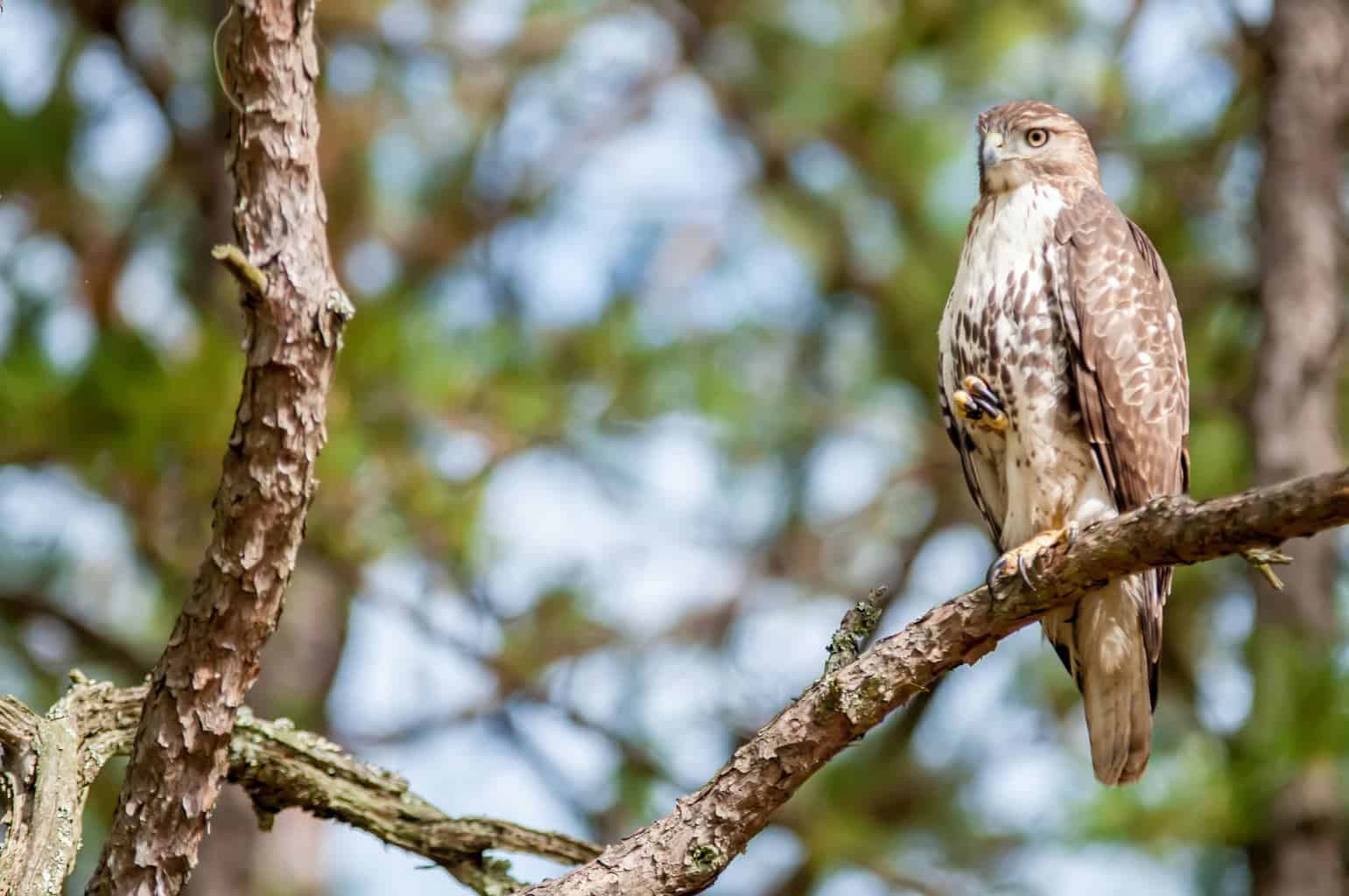
- Scientific Name: Accipiter cooperii
- Length: 14.5 to 17.7 in (males) – 17 to 20 in (females)
- Weight: 0.7 to 0.9 lbs (males) – 1.1 to 1.3 lbs (females)
- Wingspan: 24.3 to 38.9 in
Additional Information:
In addition to the Red-tailed Hawk, Cooper’s Hawk is also pretty common in Maryland and neighboring states. One of the most characteristic aspects of the bird is that they have gender dysmorphia, as females are typically rather larger than males.
However, both of them look quite similar. They have bluish-grey plumage that covers their back along with the reddish-brown bars that many other hawk species have.
You’ll have the most luck spotting them in wooded forests, but they can be seen soaring above urban areas too.
Barred Owl
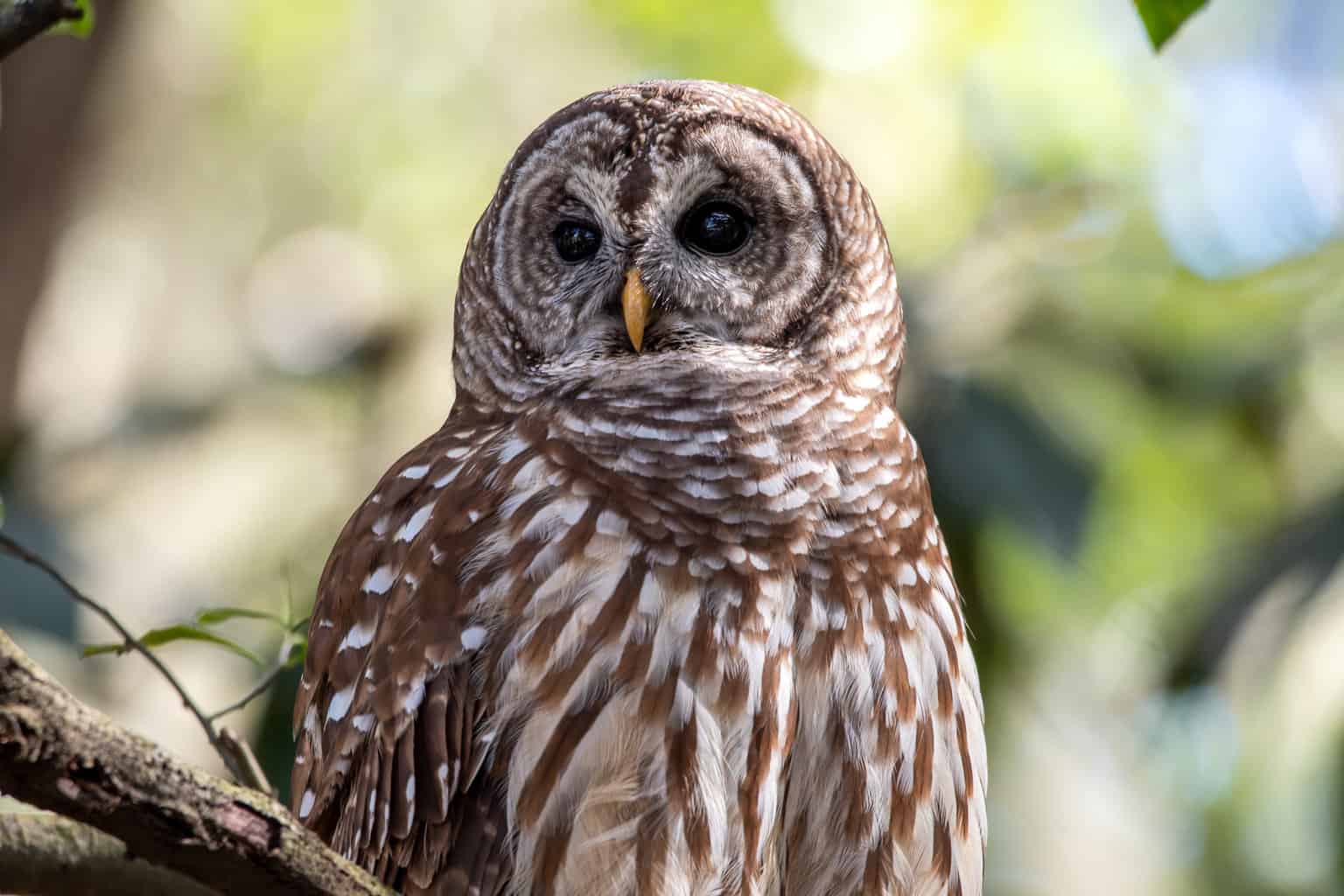
- Scientific Name: Strix varias
- Length: 16.9 to 19.7 in
- Weight: 16.6 to 37.0 oz
- Wingspan: 39.0 to 43.3 in
Additional Information:
Although the Great Horned Owl is the most common owl in the United States, the Barred Owl is the most common one in Maryland as well as other states of the Northeast.
They have an iconic heart-shaped facial disk that makes them extremely easy to identify, as this feature is only shared by Barn Owls, which look extremely different.
Other features that can help you identify them are the medium-sized greyish body with brown markings all over the back. They also have a round head with no ear tufts.
Wrap Up
For a relatively small-sized state, Maryland is home to a huge variety of bird species of different colors, sizes, and other physical features.
This makes it an amazing spot for anyone interested in bird watching from backyard feeder enthusiasts to expert birders.

